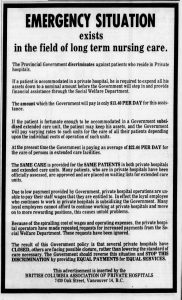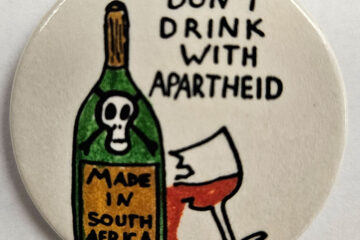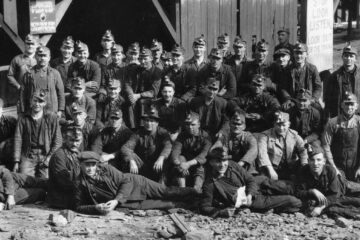The stormy history of union organizing in BC’s private hospitals
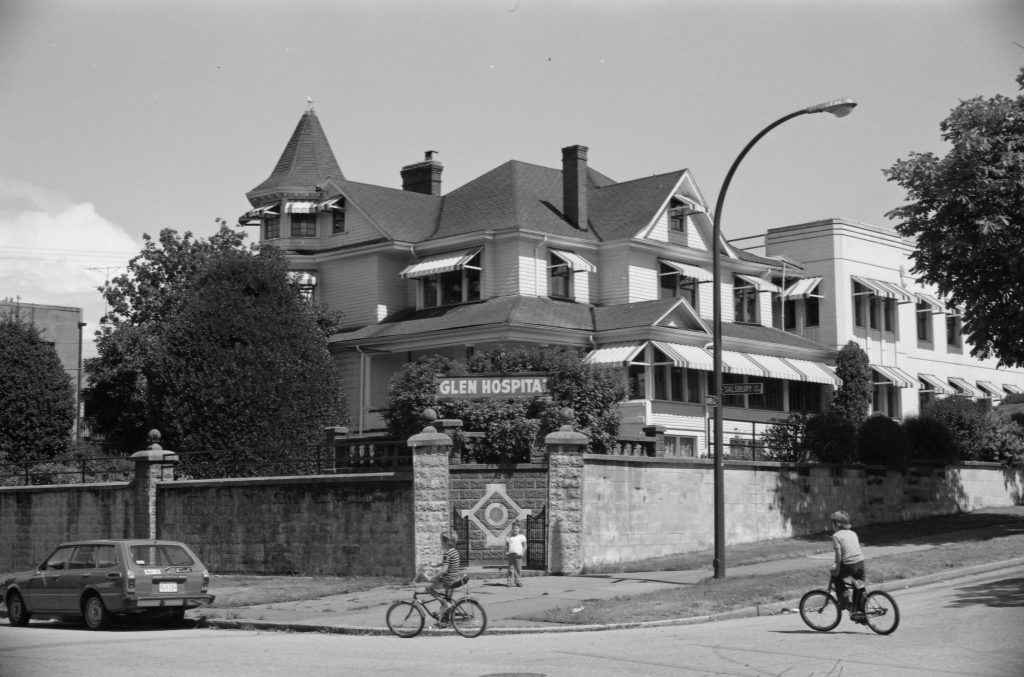
Built in 1908, received City heritage designation 1998. City of Vancouver Archives, CVA786-69.14
This story is based upon a conversation between Pam Moodie, a volunteer at the BC Labour Heritage Centre, and Aime Antoshchuk. Pam and Aime met at a Burnaby assisted living facility where the 83-year old Antoshchuk lives. We are fortunate to have the opportunity to share Aime’s union organizing experience in a BC private hospital during the 1970s. Further research and writing by BCLHC staff member Donna Sacuta.
CUPE Local 1731 organizes Glen Private Hospital
In mid-April of 1974, Amie Antoshchuk was in her mid-30s and working as a cook at the Glen Private Hospital in East Vancouver. The hospital housed elderly patients requiring ongoing care. The private hospitals were forerunners to today’s long-term care facilities and had been operating in BC since the 1950s.
The decision to get involved in organizing a union at Glen Private Hospital was an easy one for Antoshchuk. Her father was an active member of the Canadian Brotherhood of Railway Employees in Saskatchewan and a friend of CCF Premier Tommy Douglas. Her husband was a member of the International Longshore and Warehouse Union Local 500 (ILWU). Fighting for the underdog was a “fundamental family value”. 1
The workers were paid $2.81/hour and received no benefits. Working conditions were difficult. The three-storey former Edwardian mansion had no elevator; a “dumb waiter” pulley system was used to deliver food from the basement kitchen to the patients. Dishes were washed by hand. Laundry was done by three workers who carried it up and down the stairs.
Many of the workers at Glen Hospital were immigrant women or students, earning less than half of their counterparts in public hospitals. Antoshchuk says she worried about “the poor kids who were working there and getting next to nothing”.
Union planning meetings were held at Antoshchuk’s house and at the ILWU Hall. News of the union activity soon reached management. In retribution the Employer withdrew a $1 payment the workers received for washing their own uniforms. Antoshchuk’s telephone privileges were also revoked.
Workers at the Glen Private Hospital joined Local 1731 of the Canadian Union of Public Employees (CUPE) and were certified by the Labour Relations Board (LRB) in June 1974 with sixty members. Antoshchuk was secretary-treasurer of Local 1731. It was to be a long road for the CUPE members to achieve a first contract.
New Labour Code Encouraged Union Organizing
BC’s stormy political climate of the 1970s is part of this story. BC’s first NDP government was elected in August 1972, and in October 1973 introduced a new Labour Code, termed “the most progressive industrial relations system in North America”. 2
Making it easier for workers to join unions and bargain their wages and working conditions.was a core belief of the NDP’s new Labour Code. Organizing low-paid and unskilled workers in the health care field had always been difficult, but the new laws offered some hope to BC unions. As an essential service, health care unions found although they could sign up members and win a representation vote, they could never get a contract because they were not able to strike.
Sections 70 and 73 of the new Labour Code gave essential service workers the right to opt for arbitration to settle a first contract. It also prevented employers from harassing workers during organizing drives.
CUPE Local 1731 at Glen Private Hospital used the new Labour Code’s essential service rules to ask that issues like wages, vacation, holidays and sick leave be settled at arbitration. The employer had other plans that involved more than workers at just one facility.
Making a Profit from Private Hospitals
The new NDP government was ideologically opposed to the operation of private hospitals and could not stomach the idea of private interests profiting on the backs of poorly paid workers and vulnerable patients.
Premier Dave Barrett told the legislature in October 1972 that “we do not believe in the profit operations of private hospitals…nor do we believe that any employee in a private hospital should subsidize the hospital by being under-paid.” He concluded, “we mean it, and we intend to act on it.” 3

Like many of the 33 private hospitals in BC, the Glen Private Hospital was owned by a group of BC doctors, a situation BC’s Health Minister Dennis Cocke called a “conflict of interest”. However, closing them was not going to be easy. There were 3,000 beds in the private hospitals and closure would leave a huge hole in the system.
Private hospital owners were not giving in to the government. Ninety percent of patients at Glen Hospital were receiving social assistance (welfare) and their care was paid for by the Province. Owners demanded the Province increase the amount they were paid, promising that more money in their pockets would result in better conditions for workers and residents.
The BC Association of Private Hospitals said doctors had contributed a “great deal of their knowledge to make for better care” 4. There was “no harm in owners receiving liveable returns”. 5
Union organizing a challenge
Living conditions for residents of private hospitals were notoriously deplorable and workers difficult for unions to organize.
Sharon Yandle organized private hospitals in BC for the Hospital Employees’ Union during the 1970s. She says hospital workers were considered “unskilled and replaceable”. Despite more favourable laws protecting workers who wanted to join unions, sign-ups were still done “by the headlights of cars in back alleys”. 6
“Generally, [private hospital] staff work at the minimum wage in sweatshop conditions,” Yandle told a journalist in 1974. Yandle said she knew conditions were bad, but “I found conditions even worse than I imagined they would be.”
“We found 60 residents with a night staff of one. And although supposedly only elderly and not ill, we found in fact a lot of work was being performed that would require trained staff in a public hospital.” 7
Watch below for a clip from our 2016 Oral History interview with Sharon Yandle, explaining the importance of labour legislation helping to organize private hospital workers.
In December 1975, the NDP government was defeated in a provincial election, before CUPE 1731 could get an arbitrated first agreement and without having made the changes to the private hospital system that were promised.
1976 Glen Hospital Sit-In and Strike

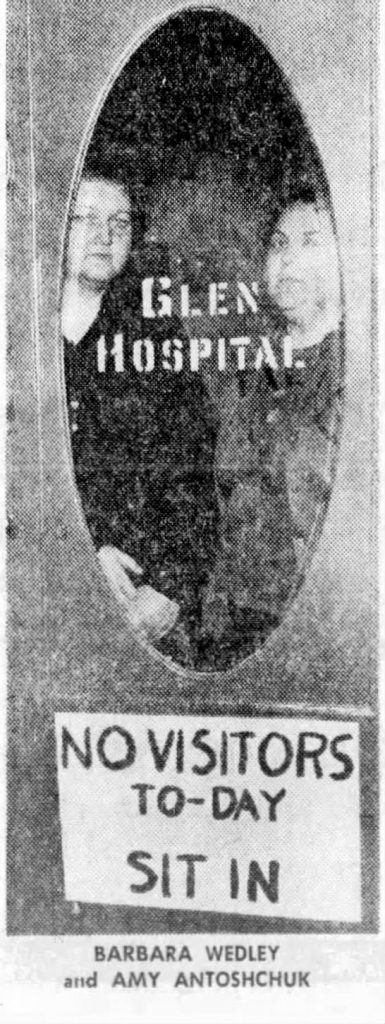 At the end of May 1976 CUPE Local 1731 members had reached their breaking point. The employer was dragging its feet on appointing an arbitrator and workers had still received no pay increase or benefits in over 2 years. On May 23, 1976, the workers at Glen Private Hospital began a sit-in to press their demands. They occupied the building, but continued to care for patients. The workers set up sleeping bags in the basement, brought their own food and prepared to stay until a contract was signed.
At the end of May 1976 CUPE Local 1731 members had reached their breaking point. The employer was dragging its feet on appointing an arbitrator and workers had still received no pay increase or benefits in over 2 years. On May 23, 1976, the workers at Glen Private Hospital began a sit-in to press their demands. They occupied the building, but continued to care for patients. The workers set up sleeping bags in the basement, brought their own food and prepared to stay until a contract was signed.
After two days the Labour Relations Board ordered the union to end their sit-in. The order prohibited the employer from disciplining staff but the hospital fired five key union supporters anyway including Antoshchuk.
Within 8 hours of being ordered to end the protest the workers walked off the job to support the fired workers, this time setting up picket lines around Glen Hospital.
The LRB immediately ordered management to stop the harassment and the Union was told to remove its pickets. The dismissal of the union leaders would follow the grievance procedure.
Antoshchuk was not reinstated to her job and went on to work in the public hospital system. She admits the experience left her “disillusioned that people didn’t understand how important it was to protect each other. The workers were equally worried about their patients and feared conditions would continue to deteriorate under the private system.” CUPE continued to represent workers at Glen Private Hospital until it closed in 1996.
Antoshchuk received a letter of thanks from CUPE leadership: “We won’t forget you or your numerous deeds and again we say thank you”. She still has the letter.
In 1977 the Social Credit government repealed Section 73 of the Labour Code, eliminating the incentive for essential service workers and their employers to reach first collective agreements.
British Columbia’s long-term care system continues to be a hybrid of public, private and non-profit ownership models in a mixture of union and non-union facilities.
- Amie Antoshchuk. Personal interview with Pam Moodie. March 2020.[↩]
- Mickleburgh, Rod. On the Line: A History of the British Columbia Labour Movement. Harbour: 2018, 184.[↩]
- British Columbia, Official Report of Debates of the Legislative Assembly (Hansard), 30th Parliament, 1st Session, 25 October 1972 p 289. (Hon Mr Barrett).[↩]
- Odam, Jes and Wyng Chow. “Doctors own fully or partly 11 BC private hospitals.” Vancouver Sun, 2 Apr 1975. https://www.newspapers.com/clip/48713684/the-vancouver-sun/ [↩]
- Braddock, John. “Why long-term patients can’t get beds.” The Province, 9 June 1973. https://www.newspapers.com/clip/48273303/the-province/ [↩]
- Sharon Yandle. Oral History Interview. BC Labour Heritage Centre Oral History Collection. 2016. https://digital.lib.sfu.ca/bclhc-12/interview-sharon-yandle [↩]
- Ford, Ashley. “Rest home employees sought in mass union recruitment.” The Province, 4 Oct 1974. https://www.newspapers.com/clip/48274695/the-province/ [↩]
